|
-- Weekly Market Update for the Week Commencing 31st January 2011
Big Picture
View
Here is a summary of our big picture
view of the markets. Note that our short-term views may differ from our
big picture view.
In nominal dollar terms, the BULL market in US Treasury Bonds
that began in the early 1980s will end by mid-2010. In real (gold)
terms, bonds commenced a secular BEAR market in 2001 that will continue
until 2014-2020. (Last
update: 09 February 2009)
The stock market, as represented by the S&P500 Index, commenced
a secular BEAR market during the first quarter of 2000, where "secular
bear market" is defined as a long-term downward trend in valuations
(P/E ratios, etc.) and gold-denominated prices. This secular trend will bottom sometime between 2014 and 2020. (Last update: 22 October 2007)
A secular BEAR market in the Dollar
began during the final quarter of 2000 and ended in July of 2008. This
secular bear market will be followed by a multi-year period of range
trading. (Last
update: 09 February 2009)
Gold commenced a
secular bull market relative to all fiat currencies, the CRB Index,
bonds and most stock market indices during 1999-2001. This secular trend will peak sometime between 2014 and 2020. (Last update: 22 October 2007)
Commodities,
as represented by the Continuous Commodity Index (CCI), commenced a
secular BULL market in 2001 in nominal dollar terms. The first major
upward leg in this bull market ended during the first half of 2008, but
a long-term peak won't occur until 2014-2020. In real (gold) terms,
commodities commenced a secular BEAR market in 2001 that will continue
until 2014-2020. (Last
update: 09 February 2009)
Copyright
Reminder
The commentaries that appear at TSI
may not be distributed, in full or in part, without our written permission.
In particular, please note that the posting of extracts from TSI commentaries
at other web sites or providing links to TSI commentaries at other web
sites (for example, at discussion boards) without our written permission
is prohibited.
We reserve the right to immediately
terminate the subscription of any TSI subscriber who distributes the TSI
commentaries without our written permission.
Outlook Summary
Market
|
Short-Term
(0-3 month)
|
Intermediate-Term
(3-12 month)
|
Long-Term
(1-5 Year)
|
Gold
|
Bullish
(27-Oct-10)
|
Neutral
(24-Jan-11)
|
Bullish
|
US$ (Dollar Index)
|
Bullish
(19-Jan-11)
| Bullish
(03-Jan-11)
|
Neutral
(19-Sep-07)
|
Bonds (US T-Bond)
|
Neutral
(20-Sep-10)
|
Neutral
(03-Jan-11)
|
Bearish
|
Stock Market (S&P500)
|
Bearish
(22-Dec-10)
|
Bearish
(11-Oct-10)
|
Bearish
|
Gold Stocks (HUI)
|
Bullish
(01-Sep-10)
|
Bullish
(23-Jun-10)
|
Bullish
|
| Oil | Neutral
(31-Jan-11)
| Neutral
(31-Jan-11)
| Bullish
|
Industrial Metals (GYX)
| Bearish
(03-Jan-11)
| Bearish
(25-May-09)
| Neutral
(11-Jan-10)
|
Notes:
1. In those cases where we have been able to identify the commentary in
which the most recent outlook change occurred we've put the date of the
commentary below the current outlook.
2. "Neutral", in the above table, means that we either don't have a
firm opinion or that we think risk and reward are roughly in balance with respect to the timeframe in question.
3. Long-term views are determined almost completely by fundamentals,
intermediate-term views by giving an approximately equal weighting to
fundamental and technical factors, and short-term views almost
completely by technicals.
Egypt's Revolution and Inflation
Unless you've been
unconscious for the past few days you are probably aware that the
situation in Egypt is becoming increasingly precarious. Increasingly
precarious, that is, for Egypt's government (the dictatorship of Hosni
Mubarak). Inspired by the fall of Tunisia's dictatorship two weeks ago,
Egyptians have taken to the streets en masse in an effort to bring
Mubarak's thirty-year rule to an end. Predictably, the Egyptian
government's response to the protests has been draconian. For example,
police have assaulted protestors with tear gas, water cannons and
rubber bullets, the military has been deployed to assist the police and
to help enforce a curfew, and the internet has effectively been shut
down.
The financial markets yawned when Tunisia's government was overthrown
and then ignored the signs of political upheaval in Egypt...until
Friday, when the "safety trade" suddenly came back into vogue. In
particular, gold, the US$ and the US T-Bond reversed upward on Friday,
while the broad stock market reversed downward. Also, the oil price
jumped as traders began to give more serious consideration to the
possibilities of the Suez Canal being closed for business and the
nascent revolutionary trend spreading to the Arab world's important
oil-exporting nations.
As an aside, while the situation in Egypt certainly had some effect on
global markets late last week and could have a bigger effect over the
days/weeks immediately ahead, the safety theme had become so 'oversold'
and the growth theme so 'overbought' of late that some sort of
correction was well overdue prior to Friday. It was just a question of
what the catalyst for a correction would be. If it hadn't been Egypt it
would have been something else.
There will undoubtedly be a lot commentary about Egypt's political
situation over the coming days, but we suspect that the bulk of this
commentary will either not deal with inflation's role in the crisis or
will incorrectly analyse inflation's role in the crisis. Therefore,
this is the aspect that we will focus on.
A large proportion of Egypt's population is poor (we've read that about
40% of Egypt's people live in abject poverty). This not only means that
there are a lot of people in Egypt who are desperate for a change, but
also that there are a lot of people in Egypt who get adversely impacted
in a big way by rising food prices (in general, the poorer the person
the greater the percentage of their income that gets allocated to basic
necessities such as food). As everyone knows, food prices have been
rising sharply in terms of most currencies over the past 6 months. This
means that for the average Egyptian, the increase in the cost of food
probably came close to tipping the scales in favour of physical
protest. Events in Tunisia earlier this month probably gave the final
push by proving that major political change could be achieved if enough
people forthrightly demanded it.
This prompts the question: what caused the so-called "food inflation"?
Most pundits will incorrectly cite grain supply issues, including the
climate-related effects of volcanic eruptions and the effects of La
Nina. A minority will correctly state that monetary issues are far more
important than commodity-supply issues, although they will tend to make
the mistake of pointing the finger of blame at the US Federal Reserve.
While any story that has the Fed as the villain has some appeal to us,
the reality is that the Fed is not to blame for inflation problems that
occur outside the US.
The Fed has unlimited power to depreciate the US dollar, but it cannot
bring about a reduction in the purchasing power of any other currency.
Only the central banks and governments of other countries are capable
of depreciating their own currencies. China is a classic example. Due
to its shortsighted mercantilist trade policy, China's government
chooses to purchase large quantities of US dollars using newly-created
Yuan. The resultant rapid growth in the Yuan supply inevitably leads to
rapid price rises within China, such as the double-digit rates of
increase over the past year in the prices of food and housing. Our
point is that China's policy-makers CHOOSE to import US inflation. They
do this because of the misguided belief that it's good strategy to
maximise the quantity of valuable goods that their countrymen exchange
for pieces of paper created by a foreign bank.
Therefore, rather than saying that the US exports inflation, it is more
appropriate to say that other countries deliberately import US
inflation. In so doing, the governments of these other countries hope
to gain a short-term advantage for their exporting industries. The
problem is that this short-term advantage for one sector of the economy
comes at the cost of a long-term inflation problem for the entire
economy.
Just in case it isn't clear, there's an important distinction between
the idea that the US exports inflation and the idea that other
countries import US inflation. Advocates of the first idea generally
portray the inflation importers as innocent, helpless victims, rather
than the pro-active inflators (or pro-inflation blackguards) that they
really are.
In support of our argument we present the following chart. This chart
provides an indication of what the long-term food price trend would
look like if food prices were denominated in a currency that was 100%
backed by gold. In terms of such a currency the average price of food
would have hit a 15-year low (perhaps even an all-time low) in
June-2010. It would have bounced over the past 6 months, but there
would certainly be no good reason for riots due to high food prices in
a country using such a currency.
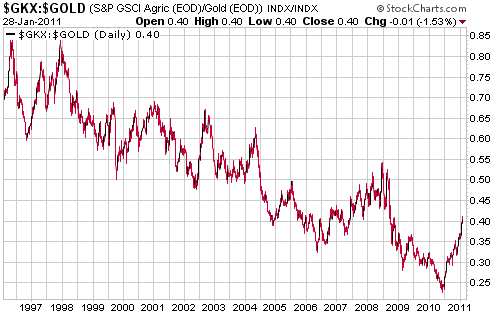
To sum up: rising
food prices have probably helped bring about the political upheaval
currently underway in Egypt, and the rising cost of food has been an
effect of monetary inflation deliberately caused by Egypt's
policy-makers.
Oil Update
In
the 19th January 2011 Interim Update we noted the strong positive
correlation between the oil price and the S&P500 Index, and stated:
"...unless
you expect war to break out in the Middle East (a Middle East war would
cause a large rise in the oil price and a concurrent large decline in
the S&P500 Index), your outlook for oil should be the same as your
outlook for the US stock market."
The risk has increased that something will occur in the Middle East to
crimp the flow of oil, potentially causing a significant divergence
between oil and the stock market for the first time in more than two
years. That's why we have upgraded our short-term oil outlook from
"bearish" to "neutral".
We have upgraded our intermediate-term oil outlook from "bearish" to
"neutral" for essentially the same reason. It's distinctly possible
that recent events in Tunisia and Egypt constitute the start of a trend
that will grow to encompass much of the Middle East within the next two
years.
We think there's a lot of downside risk in the oil price, but there's
also a lot of upside potential. When it comes to global oil supply,
politics is much more important than geology.
Interesting quote(s) of the week
The first quote is from Barry Ritholtz's blog. It is included at the top of each page where readers post their own comments on the blog topics.
"Please use the comments
to demonstrate your own ignorance, unfamiliarity with empirical data,
ability to repeat discredited memes, and lack of respect for scientific
knowledge. Also, be sure to create straw men and argue against things I
have neither said nor even implied. Any irrelevancies you can mention
will also be appreciated. Lastly, kindly forgo all civility in your
discourse . . . you are, after all, anonymous."
Perfect!
On a more serious note, the next quote comes from the 19th January article by Vijay Boyapati titled "The Politics of Deflation".
This article makes the argument that when push comes to shove the Fed
will act in the interests of the banking elite rather than the
political elite, and that it is not in the interests of the banking
elite to inflate to the extent that confidence in the currency
collapses. The author's forecast, then, is for a "controlled
deflation". Here is the article's conclusion:
"While the Federal
Reserve has the theoretical power to force the resumption in credit
expansion by monetizing enough public debt that the losses from the
housing bust are wiped away, it is unlikely to do so. The Fed was
created for the benefit of the banking class, and while it remains
under the control of that class it will not pursue a policy that would
lead to a breakdown in the monetary system from which the banking class
profits.
However, the Fed is also
unlikely to allow an untrammeled deflation to run its full course,
given the risk of political unrest that might arise. Therefore, the
Federal Reserve's most likely course of action is to keep the mortgage
market, in which most of the losses are concentrated, in a sort of
stasis where losses are acknowledged slowly over time. Such a policy,
which might well be called "controlled deflation," would lead to a
prolonged period of high unemployment and slow growth, as capital is
only slowly reallocated to satisfy consumer preferences.
Further, the insufficient
or barely sufficient creation of new credit to make up for debt paid
down -- or defaulted on -- would cause a low growth in aggregate
prices; in fact, these prices might occasionally become negative. Not
until the losses of the housing boom are fully cleared -- which might
take years under a policy of controlled deflation -- should we expect
an inflationary credit expansion and a significant rise in prices."
Needless to say (but we'll say it anyway), we disagree. Here's why:
First, the Fed exists to support the expansion of the banking system
AND the federal government, both of which benefit from controlled
INFLATION. For example, the banks, as a group, are only able to
generate outsized profits and grow as a percentage of the overall
economy due to their special ability to create new money out of nothing
(inflate the money supply, that is). The more they inflate in a
'controlled' manner, the more wealth gets transferred from other
sectors of the economy to the banking sector.
Second, neither the government nor the banks would benefit from an
out-of-control inflation, but that has always been the case and has not
prevented out-of-control inflations from erupting in the past. No
government or central bank ever sets out to destroy the currency, and
yet monetary collapses periodically occur. This happens because the
government and the central bank set out to inflate in a controlled
manner, and then lose control.
Third, the US experience of the past 50 years suggests that politics
now trumps other influences when it comes to inflation/deflation. We
note, for instance, that during the 1970s the Fed didn't take
meaningful steps to slow the rate of money-supply growth until
inflation was widely perceived as a major problem by the voting public.
In summary:
1. The government and the banking industry generally desire a "controlled inflation".
2. Contrary to the wishes of the government and the banking industry,
controlled inflations sometimes evolve into uncontrolled inflations.
3. History suggests that aggressive attempts to use inflation to
'stimulate' a weak economy only end after unwelcome price rises become
a major political issue. Only then does the central bank garner the
political support it needs to curtail the inflation.
The Stock
Market
The US stock market pulled
back on Friday, but the market remains 'overbought' and sentiment
indicators are still at levels that suggest meaningful short-term
downside risk. In particular, the put/call situation remains decidedly
bearish.
In order for us to become less bearish, the market will most likely
have to drop by at least 10%. That's probably what it will take to
bring short-term risk back into line with, or below, potential
short-term reward.
Below are two charts that we think are interesting.
The first chart shows that EWZ, an ETF that tracks the Brazilian stock
market in US$ terms, has spent the past four months oscillating within
an 8-point horizontal range. It hasn't confirmed the new multi-year
highs achieved by the senior US stock indices over the past two months,
and tested the bottom of its 4-month range on Friday.
If EWZ were to break decisively below the bottom of its range then the
short-term chart-based target would be the support that lies at around
$64.
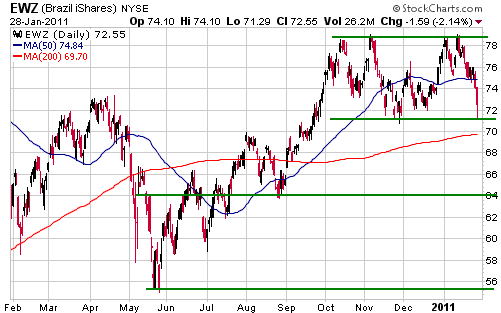
The second chart
shows that the Baltic Dry Index (BDI) is approaching the 8-year lows it
reached during the crescendo of the global financial crisis. It's just
as well that there is so much economic growth happening in the world,
because just imagine how low international shipping rates would now be
if a recession were still underway.
Actually, we don't know if the BDI's current low level is related to
the performance of the global economy. It could, for example, have more
to do with the supply of shipping than with the level of international
trade. We think it's interesting, though, that the BDI is now a lot
lower than it was when the recession was officially still in progress.
This week's
important US economic events
| Date |
Description |
Monday Jan 31
| Personal Income and Spending
Chicago PMI
| Tuesday Feb 01
| ISM Manufacturing Index
Construction Spending
Motor Vehicle Sales
| | Wednesday Feb 02
| No important events scheduled
| | Thursday Feb 03
| Q4 Productivity and Costs
ISM Non-Manufacturing Index
Factory Orders
| | Friday Feb 04
| Monthly Employment Report
|
Gold and
the Dollar
Gold
The US$ gold price broke below support at $1320 on Thursday and traded
as low as $1307 (basis the February contract) on Friday morning before
reversing upward.
The situation in Egypt was the catalyst for Friday's reversal, but from
a sentiment perspective the market was primed for a reversal prior to
Friday's events. In fact, objective evidence suggests that sentiment in
the gold market prior to last week's reversal was roughly the same as
it was in mid July of 2010 -- just prior to the start of a relentless
2.5-month advance that resulted in a $200/oz addition to the gold
price. The evidence we are referring to is the Commitments of Traders
(COT) situation and the Market Vane sentiment survey. Near the
short-term price bottom last July, the total speculative net-long
position in COMEX gold futures dropped as low as 182K contracts and
Market Vane's bullish percentage for gold dropped to 60. This is close
to the levels reached last week.
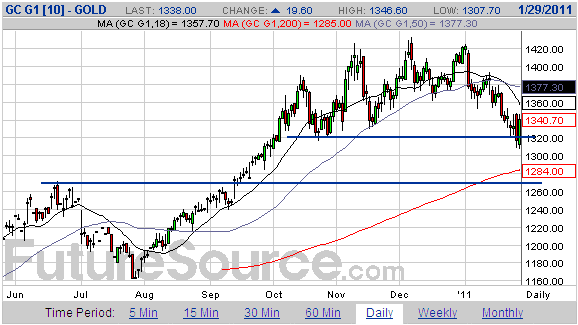
Gains in the gold
price that are made in response to geopolitical events are never
sustained, but as noted above the stage was already set for a
short-term trend reversal prior to the Egyptian news. It's therefore
possible that Friday's reversal will be followed by a multi-week rally
to new all-time highs.
We aren't forecasting a multi-week rally to new highs, but the
potential for such an outcome intrigues us because it would surprise
the maximum number of market participants and commentators. It
currently seems that a vast majority of people, including a majority of
long-term gold bulls, is resigned to seeing the gold price work its way
down to significantly lower levels, but markets tend not to do what the
vast majority expects them to do.
In our opinion, there isn't much downside risk in gold at this time. If
the market were to quickly give back last Friday's gains and drop to a
new multi-week low, the negativity would become almost palpable and the
stage would again be set for an upward reversal. We therefore view a
sustained break below last week's low as the least likely near-term
outcome.
Gold Stocks
When the gold price broke below support at $1320 and hit a new
correction low last Thursday, the HUI made a higher low. This was a
positive divergence.
Sentiment-wise, the HUI appears to be in a similar position to gold
bullion. Specifically, if it dropped to a new multi-week low, the
negativity would become so great that an upward reversal would probably
soon follow. We therefore view a sustained break below last week's low
as an unlikely near-term outcome.
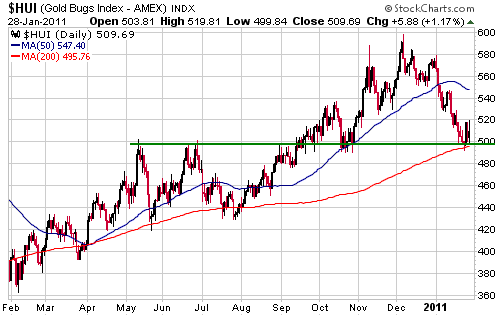
Many gold-stock
investors are no doubt worried at this time about the potential for
gold stocks to be hurt by a sharp decline in the broad stock market. In
fact, they are almost always worried about this possibility, even
though general equity bear markets are the lifeblood of gold and
gold-stock bull markets.
If the broad stock market falls far enough and fast enough then the
gold sector will naturally take a hit, but the gold sector's
vulnerability to a general stock market decline has been greatly
reduced by the downward move that has already happened. Also, any
damage incurred by the gold sector due to a general stock market
decline would be temporary and quickly eliminated during the ensuing
stock market rebound.
Finally, we want to stress that there is no urgency to do anything in
the gold sector at this time. In fact, there should never be any
urgency to do anything in any market. There were many opportunities to
do some selling into the strength that occurred in the gold sector
during the fourth quarter of last year, and there will be many
opportunities to do some buying over the months ahead. Both selling and
buying should be gradual, methodical processes.
Currency Market Update
When the March euro closed marginally above resistance at 1.37 last
Thursday it had risen for 13 trading days in a row. Thursday's high
could turn out to be important, although it is obviously way too early
to draw any conclusions.
A daily close below 1.34 would be the first definitive sign that an important euro top was in place.
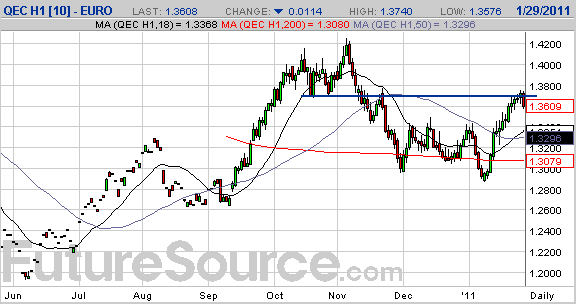
Update
on Stock Selections
(Notes: 1) To review the complete list of current TSI stock selections, logon at http://www.speculative-investor.com/new/market_logon.asp
and then click on "Stock Selections" in the menu. When at the Stock
Selections page, click on a stock's symbol to bring-up an archive of
our comments on the stock in question. 2) The Small Stock Watch List is
located at http://www.speculative-investor.com/new/smallstockwatch.html)
 Chesapeake Gold (TSXV: CKG). Shares: 38M issued, 45M fully diluted. Recent price: C$14.70 Chesapeake Gold (TSXV: CKG). Shares: 38M issued, 45M fully diluted. Recent price: C$14.70
CKG has been remarkably strong over the past two months and ended last
week at a new all-time high. Since early December the stock has gained
about 40% while the HUI has lost about 16%.
There has been no news to explain CKG's relative strength. The strength
could be the result of the recommendation of one or more other
newsletter writers, or the anticipation of a takeover bid, or the
market's belated realisation that the stock is under-valued, or
something else entirely. We have no way of knowing.
CKG has good management and, despite its recent surge, still offers
good value. However, we are going to take advantage of the stock's
current strength by removing it from the TSI List and recording a
profit of around 320% (based on our 2006 entry price of C$3.49 and
Friday's closing price of C$14.70). CKG still has plenty of upside
potential and we certainly wouldn't criticise anyone for maintaining a
position in the stock, but in many ways it is similar to Pretium
Resources (TSX: PVG) and at current prices we much prefer PVG. We also
prefer International Tower Hill (THM), another company sitting on an
elephant-sized gold deposit. THM probably has less upside potential
than CKG, but also less downside risk.
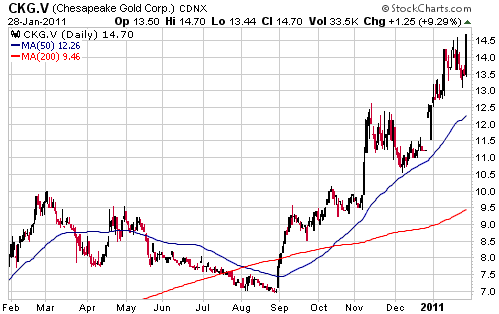
 Duoyuan Global Water (NYSE: DGW). Shares: 25M. Recent price: US$10.81 Duoyuan Global Water (NYSE: DGW). Shares: 25M. Recent price: US$10.81
In the second installment of the Barrons Roundtable, Felix Zulauf said: "It
takes about six kilos of grain to produce one kilo of beef. It also
takes 4,000 gallons of water. If I had a good water play, I would
discuss it here."
In our opinion, DGW is a good water play. DGW manufactures equipment
for waste-water treatment, water purification and water conservation,
and its business is based in a country (China) that has a worsening
shortage of quality water. The company has benefited from government
regulation and from strong growth in genuine demand, and should
continue to do so.
The stock has been weighed down over the past few months by fears that
its accounting cannot be trusted. These fears are most likely
unfounded, but will remain a significant factor as far as the stock's
performance is concerned until the currently-in-progress independent
accounting audit is complete. We don't know when this audit will be
complete, but we understand that it is not unusual for these things to
take several months.
When we added DGW to the TSI List in early November we placed a
protective 'stop' at $10.50 due to the risk that an accounting problem
would be uncovered. We had planned to include a note in today's update
to the effect that we were removing this 'stop', because a) the main
source of downside pressure on the stock price in the short-term was
more likely to be related to broad-based stock market weakness than a
company-specific issue, and b) we would view a price decline to $10.50
or lower as a buying opportunity as long as it wasn't associated with a
deterioration in the company's fundamentals. However, the stock price
fell quickly late last week and hit our sell stop during Friday's
trading session. As a consequence, the record will show that we exited
DGW on Friday at $10.50 at a loss of 15.9% and immediately returned it
to the List at Friday's closing price of US$10.81.
We think that DGW is a reasonable candidate for new buying near its current price.
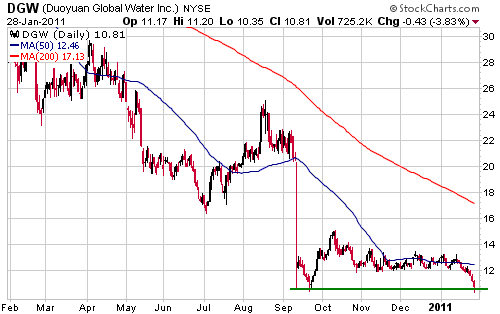
 Uranium Stocks Uranium Stocks
A sizeable downdraft in the broad stock market would probably create
good opportunities for new buying in the uranium sector. In our
opinion, EFR.TO, HAT.V and UEX.TO would be strong candidates for new
buying in the C$0.70s, the C$2.50s and the C$1.70s, respectively.
Chart Sources
Charts appearing in today's commentary
are courtesy of:
http://stockcharts.com/index.html
http://www.futuresource.com/

|

